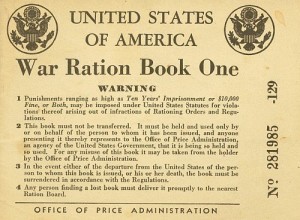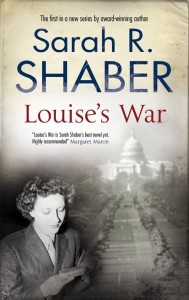 Relevant History welcomes historical mystery author Sarah Shaber. She’s the author of the Professor Simon Shaw mystery series. Simon Said, first book of the series, won the St. Malice Press/Malice Domestic Best First Traditional Mystery award. Louise’s War is the first book in her new mystery series set in Washington DC during World War II. The sequel, Louise’s Gamble, is scheduled for publication in May 2012. Sarah also edited Tar Heel Dead, a collection of short stories by North Carolina mystery writers. Sarah lives in Raleigh, North Carolina, with her husband Steve and an autocratic miniature schnauzer. For more information, check her web site, and follow her on Facebook.
Relevant History welcomes historical mystery author Sarah Shaber. She’s the author of the Professor Simon Shaw mystery series. Simon Said, first book of the series, won the St. Malice Press/Malice Domestic Best First Traditional Mystery award. Louise’s War is the first book in her new mystery series set in Washington DC during World War II. The sequel, Louise’s Gamble, is scheduled for publication in May 2012. Sarah also edited Tar Heel Dead, a collection of short stories by North Carolina mystery writers. Sarah lives in Raleigh, North Carolina, with her husband Steve and an autocratic miniature schnauzer. For more information, check her web site, and follow her on Facebook.
*****
 During World War II rationing was a fact of life. We’ve heard all about the shortages, ration books, and sacrifices made by Americans on the home front. But what exactly did it mean to make do with so much less of everything?
During World War II rationing was a fact of life. We’ve heard all about the shortages, ration books, and sacrifices made by Americans on the home front. But what exactly did it mean to make do with so much less of everything?
Of all the shortages that tested American tempers, food restrictions had the greatest daily impact. Butter, meat, canned goods, chocolate, coffee, eggs, and sugar were in short supply even before formal rationing began. Not just because the troops needed them, but because the government needed to conserve the fuel needed to transport these commodities.
Americans were accustomed to eating dessert every day, enjoying beef most nights for dinner, eggs every morning for breakfast, and consuming all the butter and coffee they wanted. Chicken and fish weren’t rationed, but at the time Americans thought of them as lesser sources of protein. Margarine and artificial sweeteners hadn’t been invented.
Sugar was the first item to be rationed officially, in May of 1942. A butter shortage followed shortly, and the average American cook wondered what in heaven’s name she was supposed to fix for dinner. New recipes crowded the women’s magazines and newspapers. Mashed potato, bacon and cheese casserole, macaroni and cheese, and Welsh rarebit became main dishes, much to the shock of those who wanted their roast beef or steak!’
 Dessert might have been the hardest loss to take. The American housewife usually baked a cake, a pie, or cookies every single day. She was expected to keep making those cakes, pies, and cookies! And prune whip wasn’t an acceptable alternative.
Dessert might have been the hardest loss to take. The American housewife usually baked a cake, a pie, or cookies every single day. She was expected to keep making those cakes, pies, and cookies! And prune whip wasn’t an acceptable alternative.
Louise Pearlie, the heroine of Louise’s War, my World War II novel set in Washington, DC, missed her sugar and butter as much as anyone. She and her fellow boarders did have eggs, because they had chickens in the back yard, but otherwise they dealt with the same restrictions as anyone else, complicated by the fact that Dellaphine, the boarding house cook, had all their ration books and kept them under lock and key! Dellaphine didn’t cook on the weekends, except for Sunday dinner, so on a Saturday Louise often found herself in the kitchen baking one of the many war cakes from the recipes in Recipes for Today, the WWII ration cookbook published by the General Foods Corporation. It was a nice break from a long week working at the spy agency OSS.
I decided to bake a war cake myself, to see what it was like to cook with such meager ingredients, and especially, to see what a war cake tasted like! I got my recipe, called the One Egg Wonder Cake, from the same cookbook Louise did, and started with the same paltry ingredients. Flour, baking powder, vegetable shortening, one cup of sugar (could have used a half cup sugar and a half cup of corn syrup), one measly egg, and a little milk and vanilla. I added some maple syrup, cinnamon and raisins to make the “spice” variation. The batter was thin and unappetizing, only about an inch deep in the baking dish. Tasting the batter did not make me optimistic about the outcome of my experiment!
 I baked the cake at 375 degrees for about 35 minutes. It came out of the oven golden brown, maybe an inch and a half high. I couldn’t frost it, of course. Louise wouldn’t have had enough sugar and butter to do that.
I baked the cake at 375 degrees for about 35 minutes. It came out of the oven golden brown, maybe an inch and a half high. I couldn’t frost it, of course. Louise wouldn’t have had enough sugar and butter to do that.
So how did it taste? Not half bad! It wasn’t as moist and rich as a “real” cake, but it wasn’t dry either. It tasted sort of like a spiced tea cake, and would have been good as an afternoon snack with milk or coffee, if there was enough of either to go around.
I’m sure Louise and her fellow boarders appreciated having this cake for dessert after a predictable meal of fried chicken, mashed potatoes, cabbage, and iced tea. I’m just as sure they’d rather have had brownies!
*****
 A big thanks to Sarah Shaber. She’ll give away one hardback copy of Louise’s War to someone who contributes a comment on my blog this week. I’ll choose the winner from among those who comment by Sunday at 6 p.m. ET. Delivery in the U.S. and Canada is available.
A big thanks to Sarah Shaber. She’ll give away one hardback copy of Louise’s War to someone who contributes a comment on my blog this week. I’ll choose the winner from among those who comment by Sunday at 6 p.m. ET. Delivery in the U.S. and Canada is available.
**********
Did you like what you read? Learn about downloads, discounts, and special offers from Relevant History authors and Suzanne Adair. Subscribe to Suzanne’s free newsletter.





